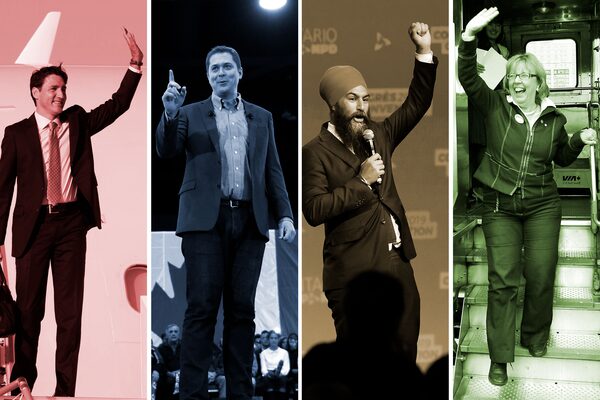
Photo illustration by The Globe and Mail (images: The Canadian Press)
The latest
- As results stream in, go here for live updates. We also have an interactive map and details on key riding outcomes.
To get in-depth coverage, sign up to the Politics Briefing newsletter, exclusive to Globe and Mail subscribers, published every weekday.
The campaign in pictures

Montreal, Oct. 21: Liberal Leader Justin Trudeau votes with his family.Sebastien ST-JEAN/AFP via Getty Images
Surrey, B.C., Oct. 20: NDP Leader Jagmeet Singh takes a selfie with a supporter at the Guildford Town Centre.David Ryder/Reuters
Richmond, B.C., Oct. 20: Conservative Leader Andrew Scheer attends a rally.Carlos Osorio/Reuters

Vancouver, Oct. 19: Green Leader Elizabeth May, middle left, sings and dances as a band plays during a rally. With her at middle right is John Kidder, her husband and the Green candidate for Mission-Matsqui-Fraser Canyon.Darryl Dyck/The Canadian Press
Saint-Jean-sur-Richelieu, Que.: Bloc Québécois Leader Yves-Francois Blanchet waves after a rally.Carlo Allegri/Reuters
Daily tracking poll
Nanos Research, in partnership with The Globe and Mail and CTV, tracked Canadians’ preferences for federal parties and leaders in a nightly survey. Throughout the campaign, the Liberals and Conservatives were in a statistical dead heat, with no distance between them that was greater than the poll’s margin of error. Learn more here about how the survey was conducted and what voters were asked.
The leaders
Justin Trudeau, Liberals
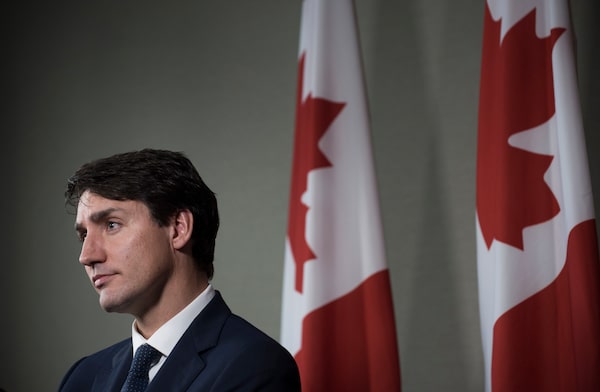
Fred Lum/The Globe and Mail
Four years ago, Justin Trudeau presented himself as a youthful optimist with a message of progressive change, and ended nine years of Conservative government. It’s not a strategy that will work twice: His main opponents are younger than he is; First Nations and environmentalists have impugned his progressive credentials because he supports the Trans Mountain pipeline extension; the SNC-Lavalin affair (more on that later) has divided the Liberal ranks; and his image has been tarnished by revelations that he wore blackface several times before entering politics. But with an economy that’s generally healthier than how he found it, despite large deficits, Mr. Trudeau can still craft a message of stability and prosperity for the “middle class” voters he courted last time. And as the world grapples with what Parliament has officially named a climate emergency, he is also trying to persuade Canadians that the Liberal carbon-pricing framework is a more credible path to a sustainable future than the Conservatives’ plan.
Profile: Justin Trudeau, the man in the middle
Andrew Scheer, Conservatives
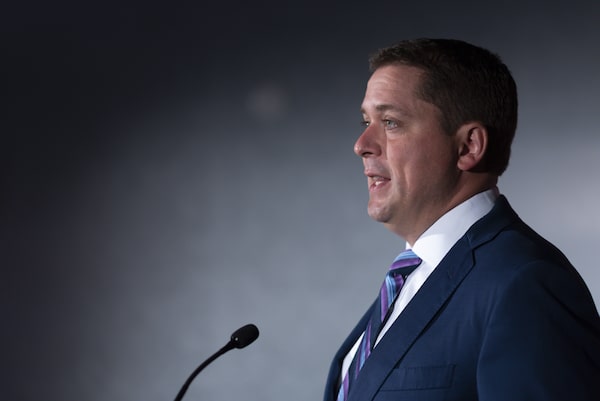
Michael Bell/The Canadian Press
When the Conservatives, chastened by Stephen Harper’s defeat, chose Mr. Scheer as leader, he was at first dismissed as “Harper lite” and a “Nowhere Man” whose political beliefs were hard to pin down. Since then, he’s found some powerful wedge issues to hammer – such as carbon pricing and a law to boost federal oversight of natural-resource projects, both of which he wants to scrap. But eliciting clear answers on, for instance, Conservative policy on abortion or his personal views on LGBTQ issues has been more difficult. Mr. Scheer has also had to speak out against racist and anti-immigrant groups seen to be supporting the Conservative cause, and to deflect questions about his aide’s past ties to the far-right Rebel Media and his own links to oil-industry lobby groups. Mr. Scheer’s hope is that Canadians either agree with him or are more fed up with Mr. Trudeau than they are afraid of a Conservative restoration.
Profile: Andrew Scheer, a work in progress
Jagmeet Singh, NDP
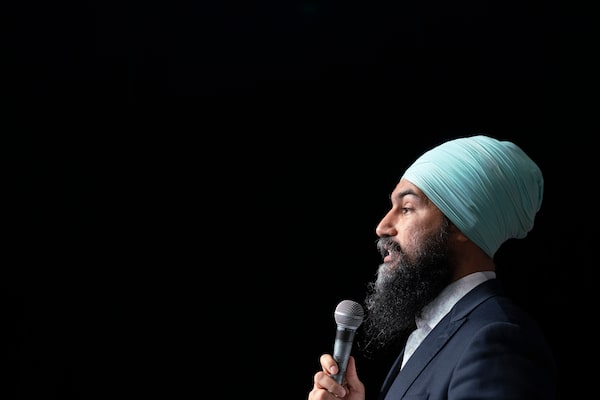
Paul Chiasson/The Canadian Press
In the 2015 election, Mr. Trudeau managed a left flanking manoeuvre on the New Democrats, who had moved more to the centre under then-leader Tom Mulcair. The party replaced Mr. Mulcair with Jagmeet Singh, a young and dapper Sikh politician from the Ontario NDP, hoping he could bring federal New Democrats back to their progressive roots. Since then, he’s had only a few months to face off against Mr. Trudeau in the House of Commons, where he didn’t have a seat until a by-election earlier this year. He’s argued that an NDP “New Deal for People” is a better plan than the Liberals’ for creating jobs and reducing economic inequality. He’s also said his NDP won’t “prop up” Mr. Scheer if the party gets the balance of power, which some surprised New Democrats interpreted as a concession that he doesn’t expect to win. “I’m running to become prime minister,” Mr. Singh later clarified.
Profile: Jagmeet Singh's unsinkable optimism
Elizabeth May, Greens
Christopher Katsarov/The Globe and Mail
When Elizabeth May took the leadership of the Greens in 2006, it was a party with no seats and little hope of breaking through into the House of Commons. But amid increasingly dire warnings from scientists about climate change, and small but significant victories by her provincial Green counterparts in Atlantic Canada and Ontario, Ms. May has seen historically high polling numbers ahead of the 2019 election. Now, she hopes to sell Canadians on an aggressive plan to phase out fossil-fuel use by the middle of this century and make more inroads into the legislature. She’s also said she’s disillusioned in Mr. Trudeau’s leadership on the environment and that, in this election, she’s not afraid of pulling votes away from the Greens’ traditional Liberal allies.
Profile: Elizabeth May's great expectations
Yves-François Blanchet, Bloc Québécois
Blair Gable/The Globe and Mail
Since the NDP and Liberals all but wiped it out in the past two elections, the federal separatist bloc has been a shadow of its past self, with too few seats even for official party status. The Bloc has cycled through eight acting or permanent leaders since 2011, the latest of which is Yves-François Blanchet, who got the job this past January when no other candidates contested him for it. Unlike most of his predecessors, Mr. Blanchet, a former Quebec cabinet minister with the Parti Québécois, hasn’t been able to count on strong support from his provincial counterparts, who were decimated in the election that brought Premier François Legault’s CAQ to power last year. One of Mr. Legault’s signature policies – a ban on teachers and many other civil servants wearing religious symbols, which a court challenge argues is discriminatory to Muslims and Sikhs – has also dogged Mr. Blanchet on the campaign trail, such as when he suggested that Quebeckers “opt for men and women who resemble you.” He denied that the remarks referred to the religious symbols law.
Maxime Bernier, People’s Party

Justin Tang/The Canadian Press
From disgraced former cabinet minister to Conservative leadership hopeful to fringe-party candidate, Maxime Bernier has had a tumultuous political life since the 2015 election. After he narrowly lost the Tories’ top job to Mr. Scheer in 2017, he denounced the new leader as too centrist and quit to create a hard-right libertarian faction, the People’s Party. His anti-immigration message and climate-change denialism have invited comparisons to U.S. President Donald Trump. Mr. Bernier’s party, however, generally polls below 3 per cent.
The issues
Climate and taxes
Climate change caused by human-made greenhouse gas emissions is an urgent threat to Canadians’ security, economy and society, not just in the near future, but now. Wildfire seasons are getting longer and more devastating; rising sea levels threaten to overwhelm the infrastructure of coastal cities; and scientists warn of a global refugee crisis caused by ecological, agricultural and social collapse. All the major parties agree climate change is a problem, but disagree about how to combat it. The Liberals introduced a nationwide carbon-pricing regime, but have struggled to get provinces to co-operate and will likely fall short of Canada’s commitments in the Paris accords. Mr. Scheer, backed by premiers who’ve had the federal tax imposed on them, wants to eliminate the carbon tax and instead use tax incentives to target large emitters, but his plan doesn’t promise to reach the Paris goals at all. The NDP plan would keep the Liberal tax but have industrial emitters pay more, while the Greens’ plan is to apply a consistent price for all emitters, pay Canadians annual carbon dividends and keep raising the price until a full transition to renewable energy is complete.
Climate policy primer: Where the four main parties stand
What is carbon pricing anyway? Learn the basics with our video primer.
Climate change and the oil patch
Fossil fuels may be the biggest culprits in climate change, but they’re also Alberta’s biggest industry, and the Canadian energy sector is reluctant to give them up – in fact, it’s been pressing for more pipeline capacity to bring oil to global markets. To win Alberta’s support for the carbon-pricing plan in 2016, the Trudeau government promised to go ahead with the Trans Mountain pipeline expansion from Alberta to B.C., going so far as to buy the system outright from Kinder Morgan when First Nations and the B.C. government opposed it. After years of legal battles over its environmental approval, the project currently has the green light again from the Trudeau Liberals, but its uncertain future and environmental costs have made it polarizing issue. The Conservatives want to push ahead with the pipeline expansion, while the NDP and Greens want to stop it.

Legend
National parks
Existing pipeline
Parks
Expansion pipeline
Terminal
Indigenous lands
Pump station
Edmonton
0
80
KM
Jasper
National
Park
BRITISH
COLUMBIA
ALBERTA
Banff
National
Park
Calgary
Kamloops
Kelowna
Westridge
Van.
Sumas
Burnaby
Ferndale
WASH.
IDAHO
MONT.
Anacortes
MURAT YÜKSELIR AND JOHN SOPINSKI / THE GLOBE
AND MAIL, SOURCE: TILEZEN; OPENSTREETMAP
CONTRIBUTORS; HIU; NATURAL RESOURCES CANADA;
OPEN GOVERNMENT; GRAPHIC NEWS; KINDER MORGAN

Legend
0
80
KM
Existing pipeline
ALBERTA
Expansion pipeline
Edmonton
Indigenous lands
National parks
Parks
Jasper
National
Park
Terminal
Pump station
Banff
National
Park
Calgary
BRITISH COLUMBIA
Kamloops
Kelowna
Westridge
Vancouver
Sumas
Burnaby
WASH.
IDAHO
MONT.
Ferndale
Pacific
Ocean
Anacortes
MURAT YÜKSELIR AND JOHN SOPINSKI / THE GLOBE AND MAIL
SOURCE: TILEZEN; OPENSTREETMAP CONTRIBUTORS; HIU;
NATURAL RESOURCES CANADA; OPEN GOVERNMENT; GRAPHIC
NEWS; KINDER MORGAN

Legend
Edmonton
Existing pipeline
Expansion pipeline
16
ALBERTA
Indigenous lands
Jasper
National
Park
National parks
Parks
2
Terminal
Pump station
97
Banff
National
Park
Calgary
1
BRITISH
COLUMBIA
Kamloops
Vancouver
Island
Kelowna
Westridge
Sumas
Vancouver
Burnaby
Pacific
Ocean
Ferndale
WASH.
IDAHO
MONT.
0
80
Anacortes
KM
MURAT YÜKSELIR AND JOHN SOPINSKI / THE GLOBE AND MAIL, SOURCE: TILEZEN; OPENSTREETMAP
CONTRIBUTORS; HIU; NATURAL RESOURCES CANADA; OPEN GOVERNMENT; GRAPHIC NEWS; KINDER MORGAN
Jobs and the economy
Expect to hear candidates talking a lot about “the middle class” in this election, especially the Liberals, whose 2015 victory hinged on promises of lower taxes and economic opportunity for middle-income families. Alberta saw some lean years under the Liberals’ watch, but heading into the election the economy has been doing well: Unemployment hit historic lows over the summer, and although it rose again in August, there are nearly a million more employed Canadians now than in 2015. Asked by The Globe this summer to grade the Liberals’ performance on the economy, more than two dozen of Canada’s top CEOs gave an A- on labour and skills and a B- on innovation, but a D+ on tax policy, which they argued was too Byzantine and hindered competitiveness. The opposition hopes to convince Canadians that things could be better if they were elected, with Mr. Scheer pledging public-spending cuts and Mr. Singh promising 300,000 new jobs as part of his party’s climate-change infrastructure plan.
Health care
Canadians spend more per capita on prescription drugs than almost any country in the world, but an advisory council created by the Trudeau government has a proposed solution for that: universal, single-payer pharmacare. Mr. Trudeau has supported the council’s plan, which would cost governments $15.3-billion when it is fully implemented in 2027, but getting the provinces on board will be a challenge. Mr. Scheer has questioned whether pharmacare would cost too much and whether the Liberals could be trusted to implement such a plan, while the NDP is trying to persuade Canadians that its own universal pharmacare plan would be better-run, would begin sooner (in 2020) and would give less influence to insurers and pharmaceutical companies.
Pharmacare policy primer: What the main parties are promising
How would universal pharmacare help the millions of Canadians who are uninsured or underinsured for their drug costs? Globe health reporter Kelly Grant explains.
The Globe and Mail
SNC-Lavalin
Some of the star cabinet ministers who came into office with Mr. Trudeau have been conspicuously absent from the Liberal hustings this time around. The reason? The SNC-Lavalin affair, which pitted former attorney-general Jody Wilson-Raybould against her boss, his staff and top public servants over whether to intervene in a Quebec construction company’s fraud and bribery case. In August, a report from the Ethics Commissioner concluded that Mr. Trudeau breached the Conflict of Interest Act in his efforts to put pressure on Ms. Wilson-Raybould in favour of a deferred prosecution, but she refused to overrule the prosecutors who didn’t want a deal. Ms. Wilson-Raybould and a minister who quit cabinet in solidarity with her, Jane Philpott, are running for re-election as Independents. As opposition leaders have challenged his moral authority to lead, and even threatened a public inquiry if they are elected, Mr. Trudeau has defended his actions, saying he was protecting jobs.
The debates
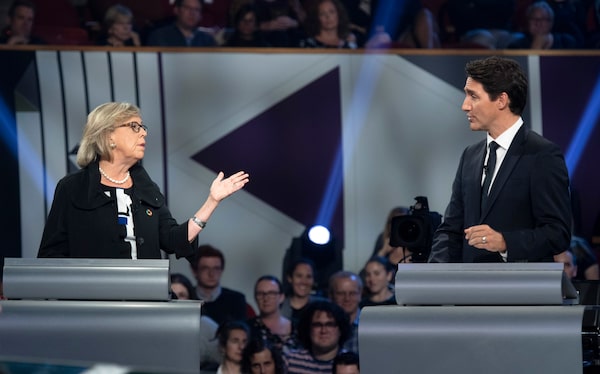
Ms. May and Mr. Trudeau participate in the Oct. 7 English-language debate in Gatineau, Que.Justin Tang/The Canadian Press
All the official campaign debates are now over. The Oct. 7 English-language debate and Oct. 10 French-language debate were organized by an independent body, the Leaders’ Debate Commission. The Liberal, Conservative, NDP, Green, Bloc and People’s Party leaders attended both.
Mr. Trudeau also attended a TVA-hosted debate with other leaders on Oct. 2, which turned out to be largely a federalist team-up against the Bloc Québécois leader. Mr. Trudeau skipped another non-commission debate held by Maclean’s magazine and Citytv on Sept. 12, and his decision to also miss the Munk Centre foreign-policy debate led to that event’s cancellation, the lead organizer says.
Recap: Maclean’s-Citytv debate, Sept. 12
Steve Patterson: Was Canada’s first election debate ‘real’, and does it even really matter?
John Doyle: We need to be better at TV election debates. A lot better
John Ibbitson: By skipping first debate, Trudeau gives rivals chance at warm-up round
Recap: TVA debate, Oct. 2
Campbell Clark: On Quebec debate stage, a very different campaign in the spotlight
Recap: English-language commission debate, Oct. 7
Watch the highlights from the Oct. 7 English-language debate.
The Globe and Mail (staff)
Flurry of attacks but no knockouts in chaotic federal leaders’ debate
Editorial: What Canadians learned from the one (and only) English-language debate
Campbell Clark: Trudeau and Scheer finally worked together – to lower the tone of the campaign
Steve Patterson: The federal leaders’ debate was historically ridiculous
John Ibbitson: Scheer fought hard in the leaders’ debate, but the night belonged to Singh
Gary Mason: The federal leaders’ debate was a mess that ignored too many Canadians
Recap: French-language commission debate, Oct. 10
Trudeau, Scheer call on Quebeckers to reject resurgent Bloc in French-language debate
Campbell Clark: Will pipeline politics drown out Trudeau’s pitch to Quebec’s progressive voters?
The digital spin, and how to watch out for it

Amr Alfiky/The Associated Press
In the years since Canada’s most recent federal election, Western countries have been waking up to the dangers of digital disinformation. Russian cyber-meddling in the 2016 U.S. presidential race, the Cambridge Analytica scandal and the rise of organized fake-news factories have put Elections Canada on guard. New federal transparency laws passed last year have compelled big tech companies to clean up their acts, and Google has banned political ads outright. If hackers do compromise the election, there’s a whole new team of Canadian bureaucrats whose job is to warn you about that.
But even with all the new safeguards, it’s up to voters to be skeptical of the political messages they see on social media. Fortunately, The Globe and Mail has tools to help you with that. This summer, the newspaper took over stewardship of the Facebook Political Ad Collector, a crowdsourcing program started by U.S.-based non-profit ProPublica. If you want to help, just install this browser extension for Chrome or Firefox and it will collect ads in a database. The Globe will use this information for editorial purposes only, and it won’t collect identifiable information about you. If you have questions, e-mail politicalads@globeandmail.com to learn more.
How do I get ready to vote?
A man casts his vote at a polling station in Montreal on Oct. 19, 2015, in the last federal election.NICHOLAS KAMM/AFP/Getty Images
- Am I registered? Canadian citizens who are 18 or older are eligible to vote. If this is your first time voting federally, then congratulations! Check here to register with Elections Canada in advance, or sign up in person at your polling place or returning office. If you’ve voted before or paid federal taxes, chances are Elections Canada already has you on their list. But riding boundaries are subject to change, so you should double-check which one you’re registered in, especially if you’ve moved recently.
- When and where do I vote? If you’re registered, you’ll get a card in the mail with the address of your polling place and the details of advance polls (which took place over the Thanksgiving long weekend). When you go to vote, be sure to bring identification to prove who you are. Here are the kinds of ID that Elections Canada accepts.
- When do we know who wins? On Monday, 338 federal seats are up for grabs, and to form a majority government, a party needs 170 or more of them. At dissolution, the Liberals haf 177, the Conservatives 95, the NDP 39, the Bloc Québécois 10 and the Greens two. The first polls in Atlantic Canada will close at around 7 p.m. (ET), then proceed east to west throughout the evening. But depending on how close the results are, there may not be a final decision until late at night or the following morning. Check back at globeandmail.com and follow The Globe’s journalists on Twitter to see the results come in.
More reading
Explainers
The definitive guide to the issues and party platforms
Climate policy: Where the four main parties stand
Taxes and deficits: Where the four main parties stand
Jobs and EI: Where the four main parties stand
Pharmacare: Where the four main parties stand
Opioids and drug policy: Where the four major parties stand
Immigration and asylum seekers: Where the four main parties stand
Housing reform: Where the parties stand, and the risks of their pledges
Who are the key campaign staff behind the scenes?
Regional roundups
Twenty-one ridings to watch from coast to coast
In small-town Atlantic Canada, Tories hope to turn back 2015's red tide
From Trois-Rivières to the Laurentians, Quebec’s battle lines are drawn
In Ontario’s 905 region, parties try to swing suburbia to their side
Leaders fly over Alberta, leaving the province largely ignored
Comment from Campbell Clark
Where is Andrew Scheer going to find $15-billion to pay for all his promises?
The money and politics behind Scheer’s foreign policy announcement
Deficit plans take backseat as federal parties seek to spend more
Trudeau hasn’t got much to say on pharmacare apart from the name of Doug Ford
Liberals unveil their crisis protocol, promise to put more money in everyone’s pocket
Comment from John Ibbitson
Party leaders must respect one another to prevent a slide into political dysfunction
Canada’s election campaign has revealed a deeply fractured country
Voter turnout could determine federal election result
Carbon wars with the provinces demonstrate why Ottawa should avoid nation-building
In this election campaign, furor is plentiful but trust is still key
Comment from Gary Mason
No, Mr. Scheer, a national energy corridor will never happen
Meaningful climate action in Canada is doomed
Justin Trudeau just helped Jody Wilson-Raybould get re-elected
The Greens’ election chances are being torpedoed – by the Greens
Comment from Denise Balkissoon
Jagmeet Singh and the costs of being Canadian
Trudeau is rich, Scheer isn’t poor – and the truly broke don’t have a say in politics
In his attempt to reach young voters, Trudeau looks stodgy in front of Hasan Minhaj
Comment from Adam Radwanski
Climate change is the defining issue for Canada, if not yet this federal election
Climate activists must get their hands dirty to drive push for political change
Does Trudeau get that Montreal’s climate march was far bigger than a mere campaign stop?
Why voters don’t need to flock to Trudeau’s rivals for his blackface controversy to cost him power
Comment from Konrad Yakabuski
Winter is coming: Why Canada isn’t prepared for the next recession
A reborn Bloc Québécois shakes up the battle for Quebec
Blackface is a permanent stain on Trudeau’s image, but will Canadians forgive him?
No, Maxime Bernier doesn’t deserve a place on the debate stage
More comment
Riley Yesno: Young people aren’t politically apathetic – we’re disillusioned
Tim Querengesser: Why Canada’s federal elections ignore cities
Vicky Mochama: In this election, what’s a black voter to do?
Lori Turnbull: Talk of a Canadian coalition is all sound and fury, signifying nothing
Globe and Mail editorials
Honey, it’s Ottawa calling, and they’re offering the best cellphone deal ever
The pros and cons of Andrew Scheer’s foreign aid plan
On climate change, the Liberal plan (mostly) adds up. The Conservative platform doesn’t
The Liberal platform: Some good, some bad, all familiar
The Liberal and Conservative home-ownership plans will only heat up Canada’s hot housing markets
Lower taxes or more benefits? Liberals and Conservatives have different answers
The NDP, the Greens and some promises that just don’t stack up
Compiled by Globe staff
With reports from Michelle Zilio, Marieke Walsh, Bill Curry, Robert Fife, Kristy Kirkup, Shawn McCarthy, Evan Annett and The Canadian Press